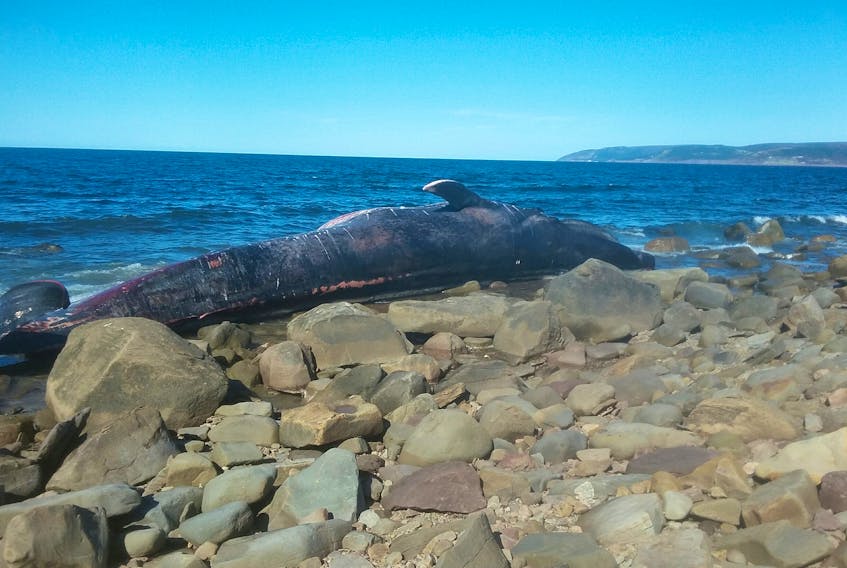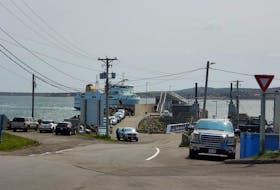PORT HOOD, N.S. — Officials with the Nova Scotia Marine Animal Response Society are hoping the carcass of a juvenile blue whale that washed up on a beach in Inverness County will be moved this week.
Andrew Reid, the society's response co-ordinator, said it’s hoped the whale will be towed to a better location, so a necropsy can be performed.
“It’s really DFO leading that effort,” he said. “We will work with our fishery colleagues in P.E.I. and DFO to make sure this animal gets examined so we can learn as much as we can from it,” he said.
“We have provided advice on the animal and what might be needed to tow it. We are waiting to hear but I don’t know if they’ll be making that final discussion today.”
Reid said when a person hears "blue whale," they immediately know they are dealing with a large animal that can get up to 90-100 ft. long and weigh up to 100 tons.
A juvenile blue whale is much smaller and lighter than an adult. There has been discussion on what boat might be needed to move an animal like this obviously not quite as large you would need for an adult animal.
For the right whales recently washed ashore coast guard vessels were utilized.
“I believe what’s often recommended is you have a boat at least as long as the whale you’re trying to tow,” Reid said.
Reid said the goal of a necropsy is in determining what led to the demise of the animal, to see if any human activities were involved or another causes.
Whether there are any opinions so far, it’s too early to speculate, he said, adding they have to wait for the detailed analysis to be completed.
The Nova Scotia Marine Animal Response Society responded to a sighting of the whale on a rocky, remote coastline at Sutherland’s Cove last week and collected preliminary information. It was determined to be a juvenile blue whale, due to its length of 18.8 metres.
Ashley Jackson, communications with DFO Canada, said a sighting of the whale was reported to the DFO on Sept. 18. It was first seen by a person who noticed the carcass from across the cove. Jackson confirmed DFO is in contact with their marine response partners about the feasibility of towing the whale to a more easily-accessible shore for a possible necropsy.
Carol Morris of Colindale, Inverness Co., heard about the whale last Thursday from a retired fisherman and went to see it, adding it was really quite a hike to reach it.
“I just sat on a rock and looked at him in awe for the first little bit,” she said. “What a waste of a beautiful, beautiful creature. I had to apologize to him because I’m not sure what happened to him."

Morris said she took a number of photos to document the whale, as she wasn’t sure who had been there yet and was afraid it could wash away. Although there was a fishy odour, she said, there wasn’t a strong repulsive smell, leading her to believe the whale hadn’t been washed up for long.
Morris said she does want to advise the public — anyone thinking of going to the area — that the whale is in kind of a dangerous spot as the surf comes in quite close to the cliff. The day she was at the site, there was a big surf on.
“I waited for about an hour until the tide was going out a little bit.”
Although the surf was high, the waves didn’t even budge the massive creature, she said, adding she also hopes the examinations provide answers.

“The big thing is getting people caring more about what goes on in the ocean,” she said.
“When I was leaving I thought to myself, 'I’m standing beside one of the biggest species ever on the planet and I should never have been given that privilege.'”
Reid said as well as determining what happened to the animal, the examination also provides an opportunity to collect scientific information. With any animal that washes ashore, they try to learn as much as they can from it.
Blue whales are protected under both the Endangered Species Act and the Marine Mammal Protection Act. They have been listed as endangered under the Act since 1970 and, according to DFO, it estimated they do not exceed more than 250 adults in the Atlantic region.
Reid believes this is the first blue whale carcass found in the maritime region. There have been a few carcasses found offshore that were in decomposed and unable to be examined, as it wouldn’t have been feasible to bring them ashore for a necropsy.
"So we couldn’t confirm whether they were blue whales or any other species.”
As with any whale species, there is always concern finding one deceased given the dwindling population in our region, he said.
“It’s definitely concerning when there’s not too many of them left.”
RELATED:
Blue whale carcass washes ashore in Port Hood
Petit Etang residents dealing with aftermath of dead right whale towed to their community
Cause of death of fin whale on Cape Breton beach still unknown









